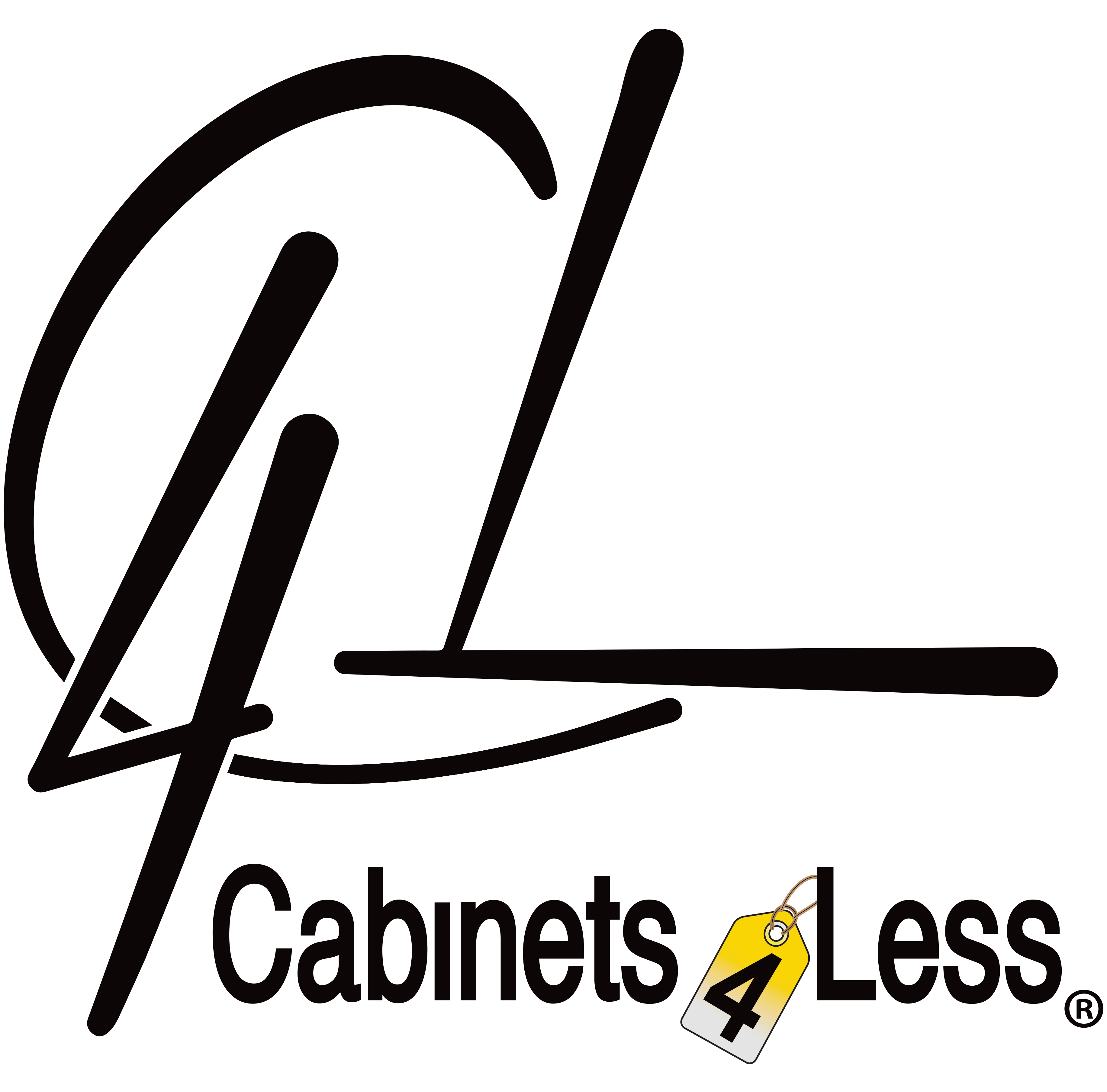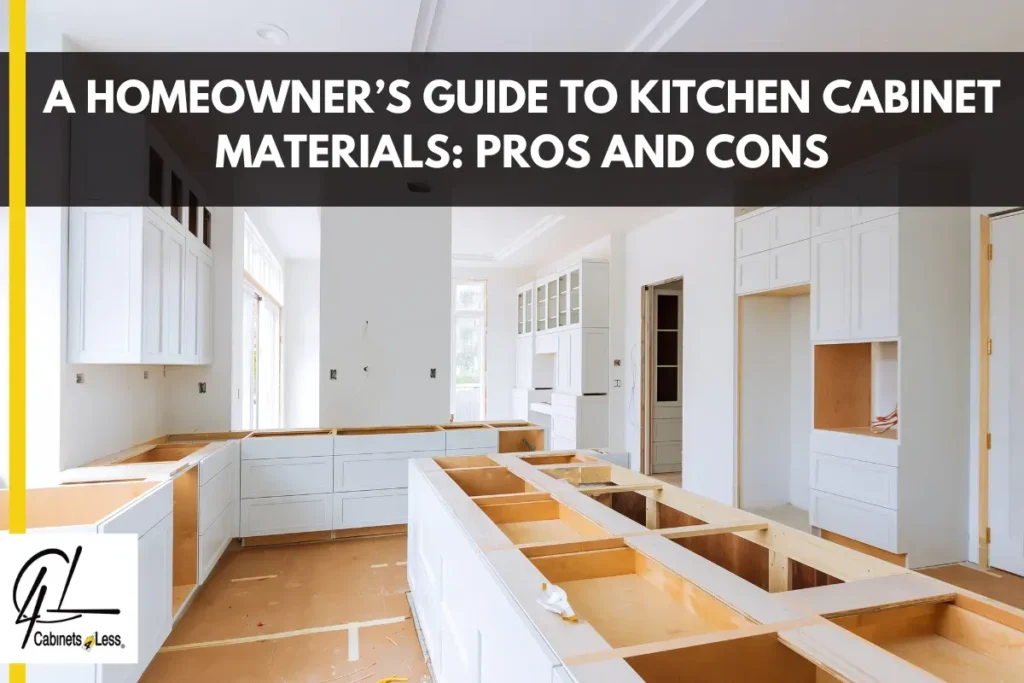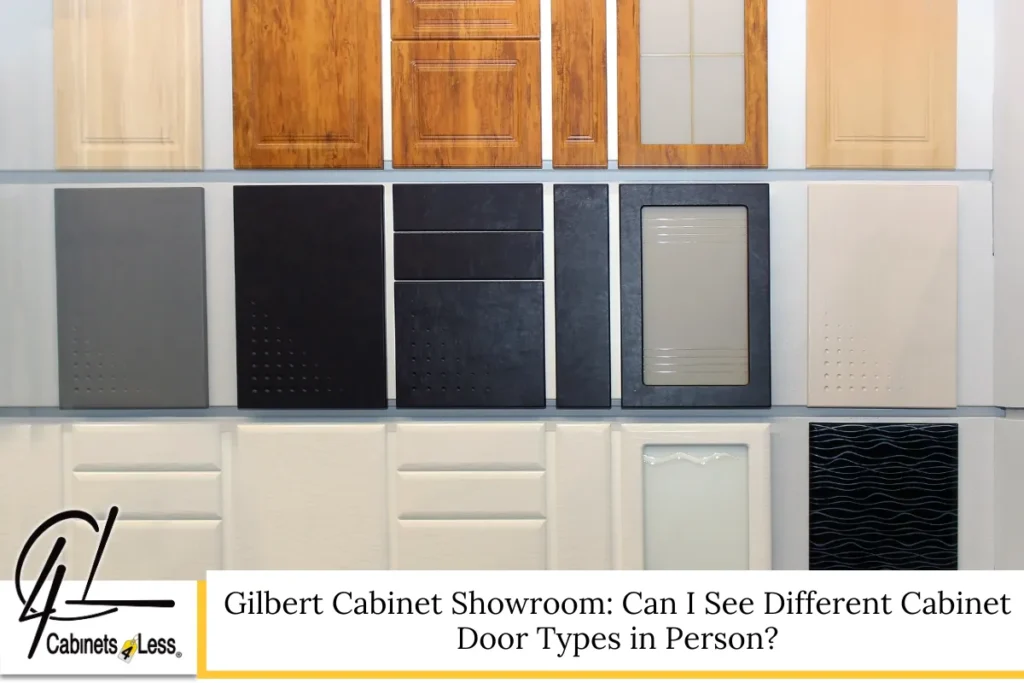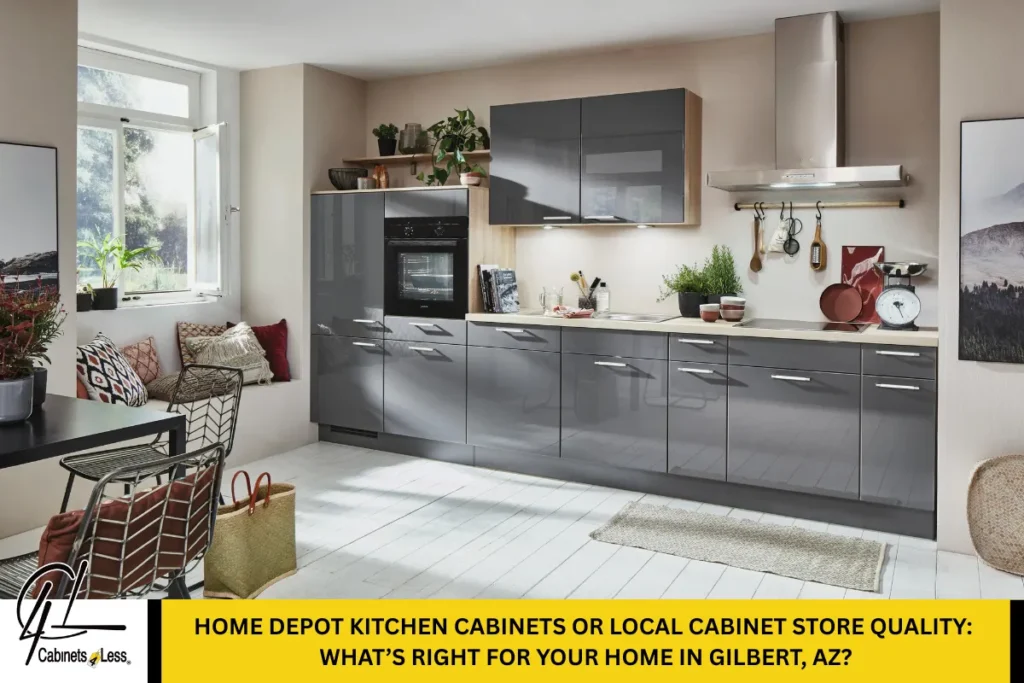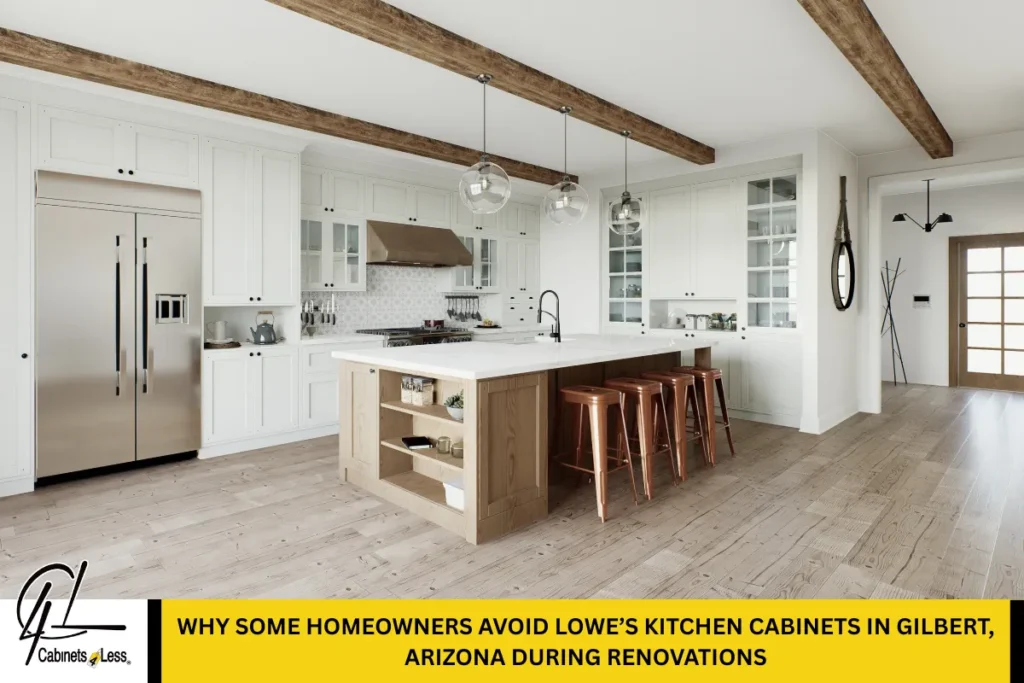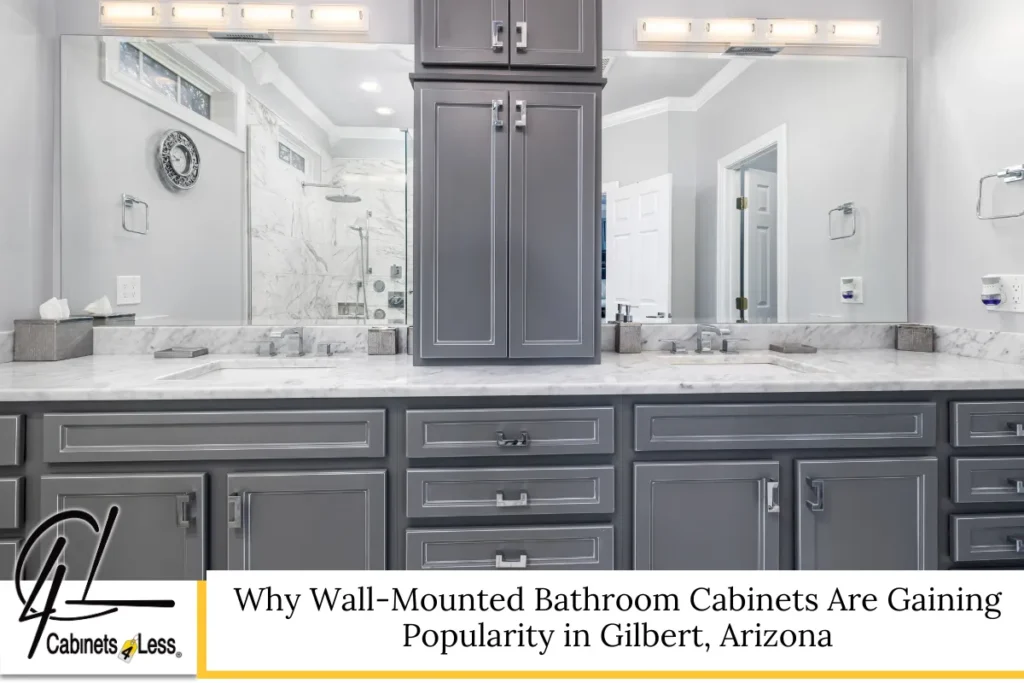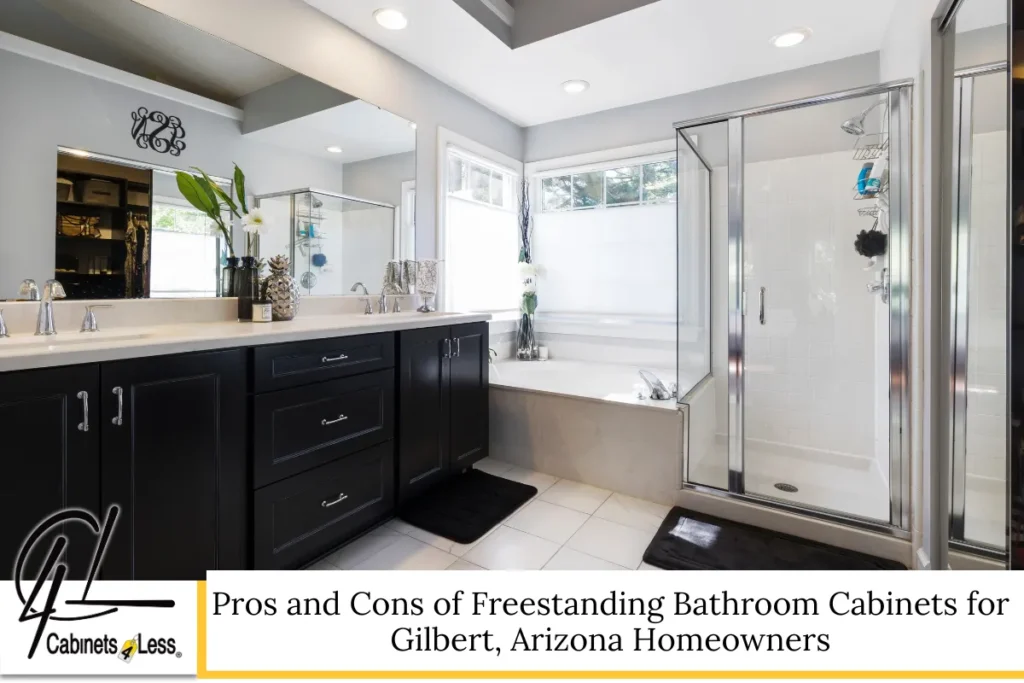Your kitchen is the heart of your home, and the cabinets are one of its most important parts. They set the style, add storage, and take a beating from daily use. But when it’s time to choose kitchen cabinet materials, many homeowners feel overwhelmed. Should you go for solid wood cabinets, MDF, laminate, or something more modern like stainless steel? Each option has its own pros and cons—and choosing the right one depends on your lifestyle, budget, and kitchen design.
In this guide, we’ll walk you through the most popular types of kitchen cabinet materials, break down their strengths and weaknesses, and help you make a smart decision that matches your space and needs. From durability and maintenance to cost and style, we’ve got you covered.
Choosing the Right Material for Your Kitchen Cabinets
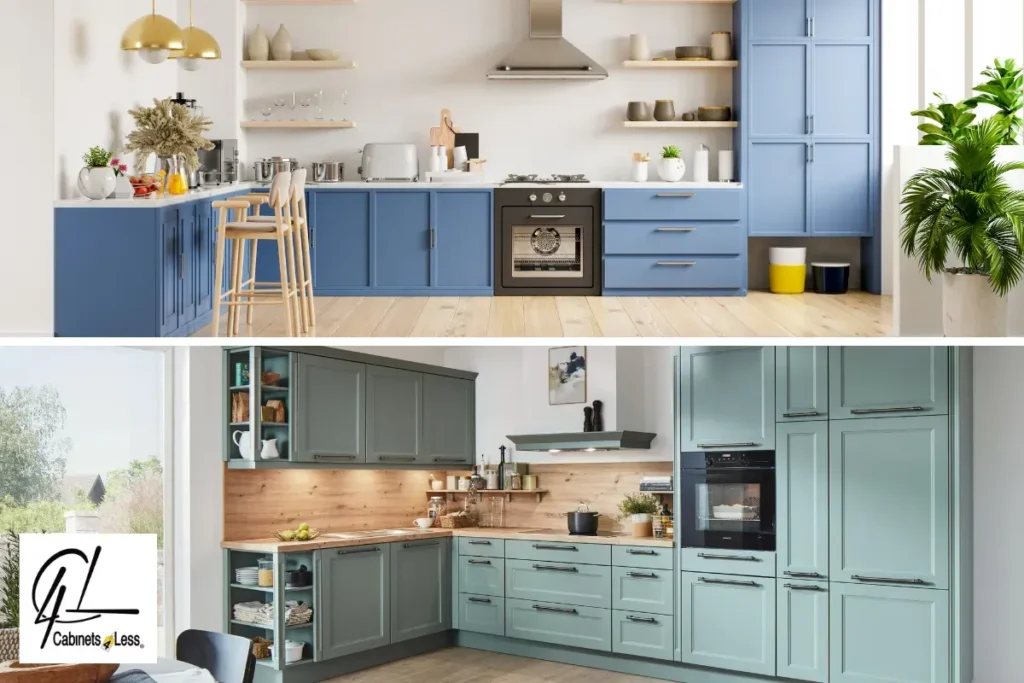
Before diving into material types, it helps to understand what matters most when selecting your kitchen cabinets. Here are the top factors to consider:
✅ Budget
Do you want a premium, long-lasting solution or a more budget-friendly option that gets the job done without breaking the bank?
✅ Moisture Levels
Is your kitchen often humid? Are there chances of moisture damage from sinks or steam? Some materials are more moisture resistant than others.
✅ Design Style
Whether you’re going for natural wood tones, solid color modern looks, or minimalist design schemes, certain materials suit different aesthetics.
✅ Usage
Are you remodeling a rental property or upgrading your forever home? Think about how long you plan to use the space and the wear it will face.
✅ Maintenance Needs
Some materials are easier to clean and maintain than others. If you want minimal maintenance, that narrows your choices.
| Material | Durability | Cost | Water Resistance | Maintenance | Appearance Options | Eco-Friendly |
| Solid Wood | ★★★★★ | $$$ | ★★☆☆☆ | ★★☆☆☆ | ★★★☆☆ | ★★☆☆☆ |
| Plywood | ★★★★☆ | $$ | ★★★★☆ | ★★★☆☆ | ★★★☆☆ | ★★☆☆☆ |
| MDF | ★★★☆☆ | $ | ★★☆☆☆ | ★★★☆☆ | ★★★★☆ | ★★☆☆☆ |
| Particleboard | ★☆☆☆☆ | $ | ★☆☆☆☆ | ★★★☆☆ | ★★☆☆☆ | ★☆☆☆☆ |
| Laminate | ★★★☆☆ | $ | ★★★☆☆ | ★★★★☆ | ★★★★★ | ★★★☆☆ |
| Thermofoil | ★★☆☆☆ | $ | ★★☆☆☆ | ★★★★☆ | ★★★★☆ | ★★★☆☆ |
| Stainless Steel | ★★★★★ | $$$$ | ★★★★★ | ★★★★☆ | ★★★☆☆ | ★★★☆☆ |
| Bamboo | ★★★★☆ | $$ | ★★★☆☆ | ★★★☆☆ | ★★★☆☆ | ★★★★★ |
Overview of Common Cabinet Materials
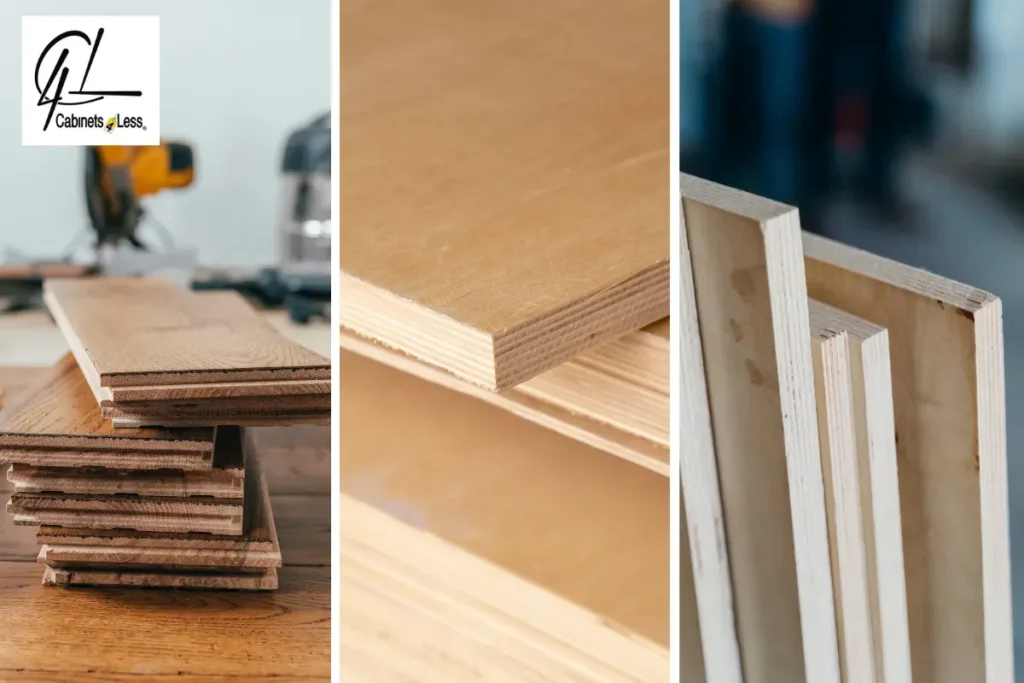
Let’s break down the most popular kitchen cabinet materials and explore their benefits and drawbacks.
Solid Wood: Timeless Elegance and Durability
What is it?
Solid wood cabinets are made from natural wood like maple, cherry, oak, walnut, or hickory. Each type has its own grain pattern and natural colors.
✅ Pros:
- Exceptional durability and strength
- Natural beauty with a unique grain and warm appearance
- Can be sanded, refinished, or painted
- Adds value to your home
❌ Cons:
- Expensive option with higher material cost
- Sensitive to humidity and moisture damage
- Maintenance requirements are higher
Solid wood cabinets are perfect if you want unparalleled durability and a classic, natural look, though they do require care and a higher upfront cost.
Medium-Density Fiberboard (MDF): Cost-Effectiveness and Versatility
What is it?
MDF cabinets are made from wood fibers and resin, pressed into smooth panels. They’re a popular engineered alternative to natural wood.
✅ Pros:
- Smooth surface ideal for painted finishes
- Won’t crack or warp like natural wood
- An affordable option for tight budgets
❌ Cons:
- Not moisture resistant—swells with excessive moisture
- Less durable than solid wood
- Can chip easily
MDF is a favorite in modern kitchens thanks to its clean, uniform surface and versatility in design. It’s a great option for budget-friendly remodels or custom-painted cabinetry.
Laminate Cabinets: Affordability and Easy Maintenance
What is it?
Laminate Cabinets are made by layering a printed decorative surface (like a wood grain or solid color) over MDF or particleboard.
✅ Pros:
- Wide range of colors and finish options
- Scratch-resistant and easy to clean
- Budget-friendly option
❌ Cons:
- Limited color repairability—can’t be refinished
- Less heat-resistant
- Can chip along the edges
Melamine kitchen cabinets fall under this category, offering a smooth, decorative surface that works well in busy kitchens. They’re a durable option for homeowners looking for easy maintenance and attractive options.
Thermofoil: Low Maintenance and Budget-Friendly
What is it?
Thermofoil cabinets are made by applying a vinyl film over MDF, creating a smooth, seamless appearance.
✅ Pros:
- Reflective surface adds shine and brightness
- Minimal maintenance and easy cleaning
- Great option for budget-conscious homeowners
❌ Cons:
- Vulnerable to heat damage from ovens and toasters
- May peel over time
- Difficult to repair once damaged
Thermofoil is a friendly option for homeowners who want the look of painted cabinets without the high cost or effort.
Plywood: Strength and Reliability
What is it?
Plywood cabinets are built from thin layers of wood veneer glued together with alternating grain directions, enhancing strength.
✅ Pros:
- Moisture resistant and stable
- Lightweight yet very strong
- Offers enhanced durability for everyday use
❌ Cons:
- More expensive than MDF or particleboard
- Exposed edges need to be covered or sealed
Plywood is often used in cabinet box construction for its strength-to-weight ratio and long-term reliability.
Exploring Emerging Cabinet Materials
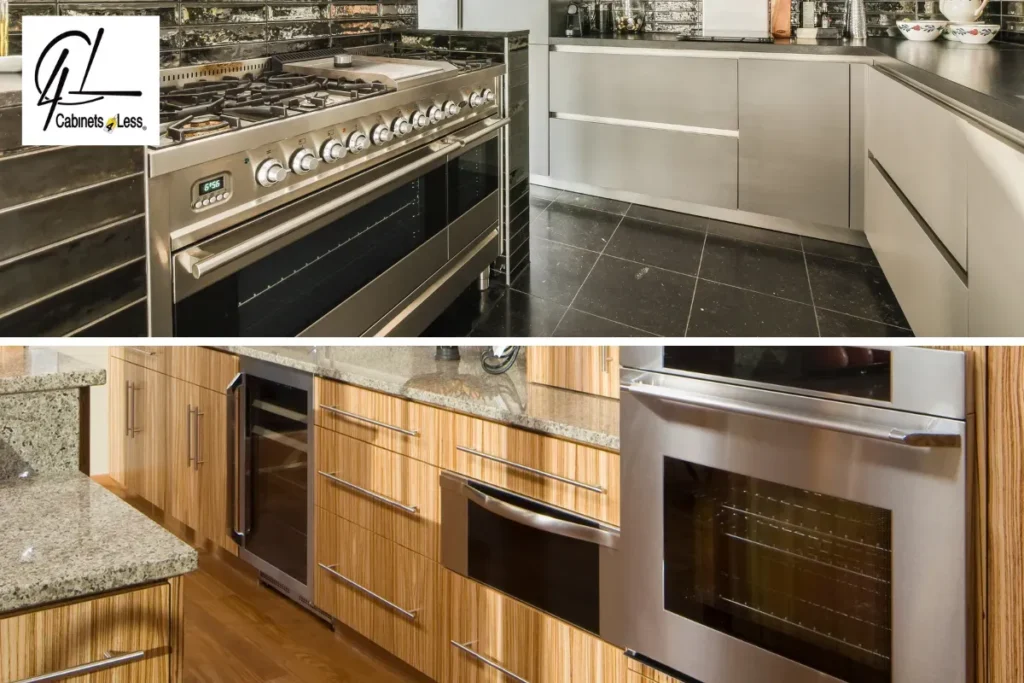
Looking for something different? Here are a couple of standout materials:
Stainless Steel Cabinets
- Ultra-modern, sleek appearance
- Resistant to heat, moisture, and stains
- Easy to clean but shows fingerprints easily
- Often an expensive option
Bamboo Cabinets
- A sustainable option made from recycled fibers and fast-growing bamboo
- Durable and moisture resistant
- Natural color options and unique grain patterns
- Eco-friendly, but still less common
These materials are ideal if you’re after sustainable options or bold, industrial kitchen designs.
Detailed Analysis of Material Characteristics
🛠️ Durability:
Solid wood, plywood, and stainless steel offer exceptional durability. MDF and laminate are durable options if moisture levels are low.
🎨 Aesthetic Appeal:
Solid wood and wood veneer cabinets provide natural colors and grain, while laminate and thermofoil offer a wide range of colors and styles for modern designs.
💰 Cost Considerations:
Solid wood is an expensive option with high upfront cost. MDF, thermofoil, and laminate are more affordable alternatives with lower initial costs.
🧽 Maintenance Needs:
Thermofoil, laminate, and stainless steel require minimal maintenance. Solid wood needs more upkeep but offers timeless charm.
The Role of Door Styles in Material Selection
Cabinet door styles—like shaker, slab, or raised panel—can impact your material choice. For example:
- Shaker styles work well with painted MDF
- Slab doors suit laminate and thermofoil finishes
- Raised panels highlight the grain of natural wood
Different styles support different materials based on thickness, grain visibility, and finish compatibility.
Finish Options for Kitchen Cabinets
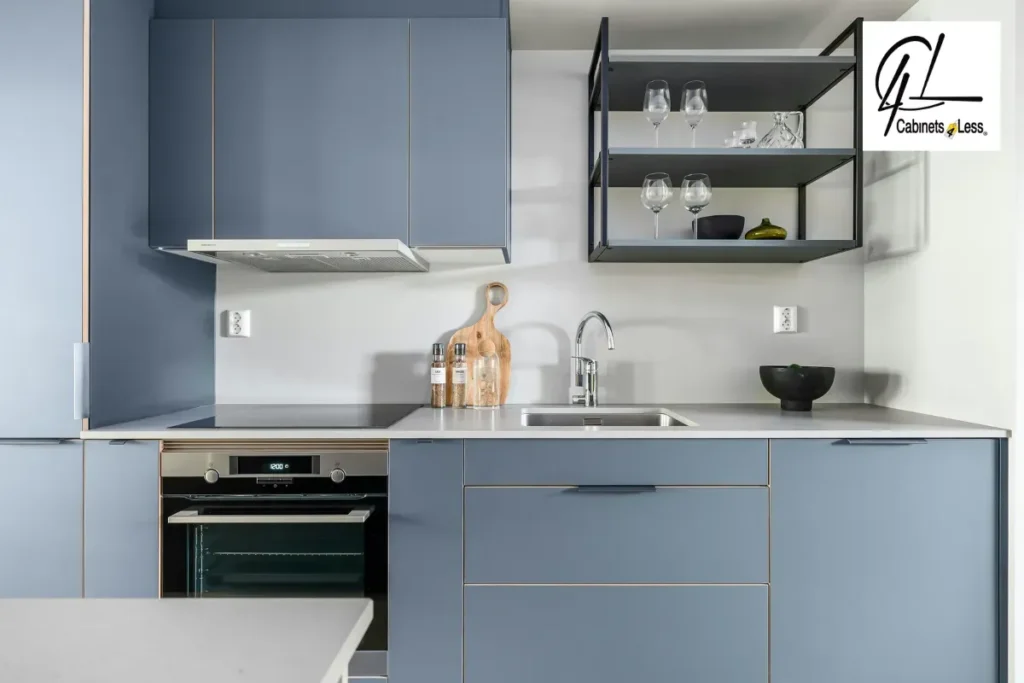
Finishes do more than look pretty—they protect your cabinets from wear, moisture, and scratches.
Popular finish options include:
- Paint (great for solid color or bold looks)
- Stain (enhances natural wood grain)
- Laminate (decorative and low-maintenance)
- Veneers (real wood surface for an upscale appearance)
Trends now include matte finishes, bold colors, and even recycled wood finishes that offer a unique, environmentally friendly appearance.
Expert Tips and Advice
Here are a few final thoughts from the pros:
- Avoid choosing materials based only on looks—consider durability and maintenance too.
- For high-moisture kitchens, avoid fiberboard without a sealed finish.
- Schedule a design consultation or even 3D design consultations to visualize your space.
- Wood veneer cabinets offer a good balance between cost and natural beauty.
- Match materials with your lifestyle. A busy family might prefer easy-to-clean laminate over solid wood.
Finding the Perfect Fit for Your Kitchen
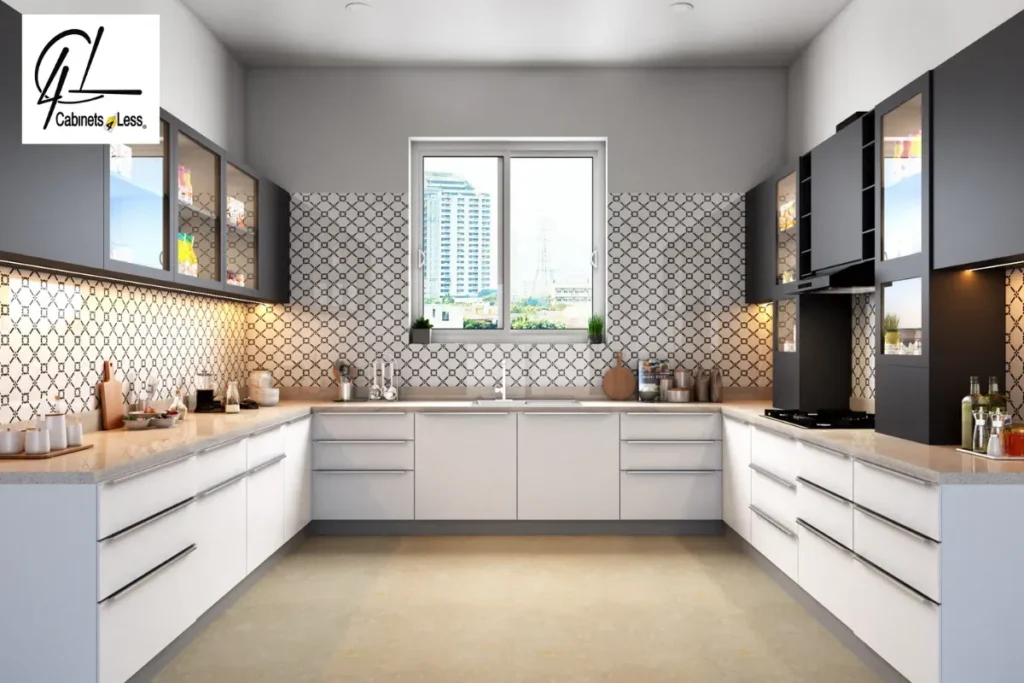
The best material for your kitchen cabinets isn’t always the most expensive—it’s the one that fits your needs. Whether you’re aiming for natural wood warmth, the sleek look of laminate cabinets, or the budget-friendly ease of thermofoil, understanding the pros and cons helps you make a confident, informed choice.
When in doubt, talk to a local cabinetry expert or schedule a professional design consultation to explore your finish options, evaluate moisture levels in your space, and find a durable, attractive option that suits your goals.
Gilbert Kitchen Cabinets – C4L Cabinetry
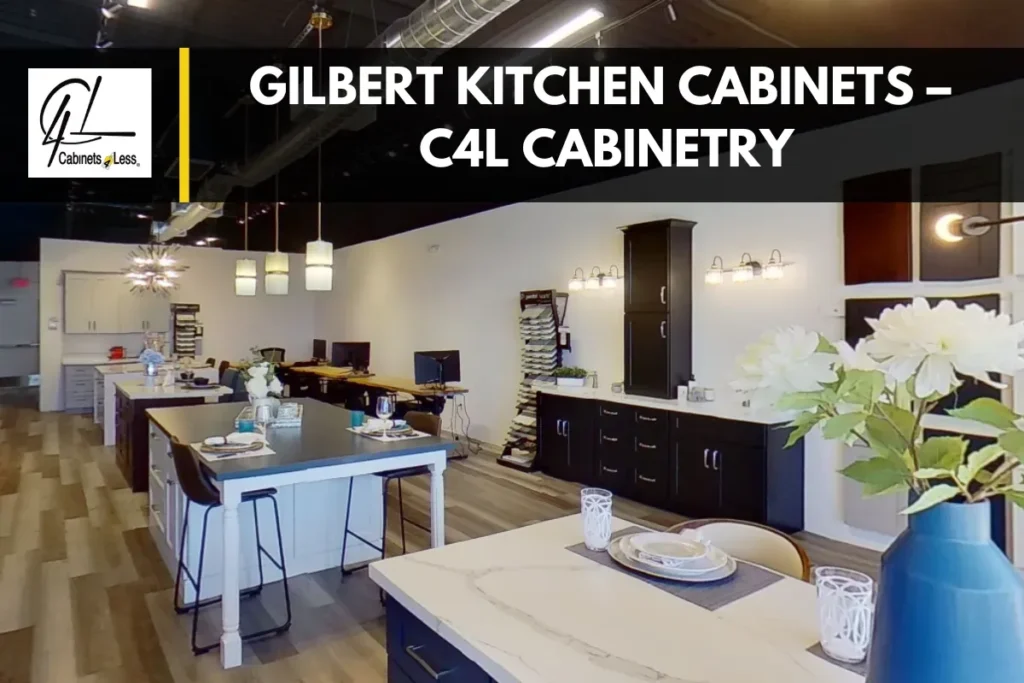
At C4L Cabinetry in Gilbert, Arizona, we make it easy to upgrade your kitchen with cabinets that are both stylish and built to last. Whether you’re dreaming of a warm, natural wood look or a modern, low-maintenance finish, our team is here to help you find the perfect fit for your home and lifestyle.
We offer a variety of cabinet materials to suit your needs—everything from classic wood to easy-care options like laminate and thermofoil. Our design experts are happy to walk you through your choices and help you create a space that feels just right.
Stop by our Gilbert showroom to explore your options, or call us to schedule a free consultation. We’ll help you make confident decisions that bring out the best in your kitchen.
Contact us today at (480) 892-5126 to get started on your project with a friendly, experienced team you can trust.
FAQ: Kitchen Cabinet Materials and Quality Guide
How to identify a poor-quality kitchen?
Poor-quality kitchen cabinetry often results in frequent repairs, inefficient storage space, and low visual appeal. To recognize inferior products:
- Check the core material:
- Particle board is a budget-friendly alternative but lacks structural integrity.
- Avoid synthetic materials with a weak vinyl layer or thin base material.
- Particle board is a budget-friendly alternative but lacks structural integrity.
- Inspect the construction:
- Weak joints, no soft-close hinges, and improper installation are warning signs.
- Lack of sealing around edges leads to reduced moisture resistance.
- Weak joints, no soft-close hinges, and improper installation are warning signs.
- Finish and feel:
- A glossy finish or high-gloss finish may look good but can peel if not applied well.
- Check for a smooth finish with no bubbling or roughness.
- A glossy finish or high-gloss finish may look good but can peel if not applied well.
- Cabinet door type and shapes:
- Warped or misaligned cabinet shapes reflect low quality.
How much do kitchen cabinets cost?
The cost of kitchen cabinetry depends on the type of material, design complexity, and installation. Here’s a basic price breakdown:
- Stock cabinets: $100–$300 per linear foot.
- These are mass-produced, offering a range of colours and variety of styles.
- These are mass-produced, offering a range of colours and variety of styles.
- Semi-custom cabinets: $150–$650 per linear foot.
- Offers more cabinet door type options and sizing flexibility.
- Offers more cabinet door type options and sizing flexibility.
- Custom cabinets: $500–$1,200+ per linear foot.
- Built to fit specific needs, using expensive cabinet material like Hardwood Cabinets or stainless steel cabinetry.
- Built to fit specific needs, using expensive cabinet material like Hardwood Cabinets or stainless steel cabinetry.
Materials also affect cost:
- Plywood kitchen cabinets: Mid-range pricing, strong and durable.
- Melamine cabinets: Affordable materials with a smooth appearance.
- Solid wood kitchen cabinets: Premium pricing for timeless beauty and durable cabinet materials.
Are custom cabinets worth the investment compared to stock cabinets?
Custom cabinets are often a smart investment depending on your needs and home value:
- Advantages:
- Tailored to your cooking space and storage needs.
- Use of quality kitchen cabinet materials like Hardwood Cabinets.
- Flexible cabinet door type and cabinetry choice.
- High resale value in upscale homes.
- Tailored to your cooking space and storage needs.
- Stock cabinets:
- Great for quick renovations or rental units.
- Feature laminate kitchen cabinets or melamine cabinets as a durable alternative.
- Offer a wide variety of common types at a lower cost.
- Great for quick renovations or rental units.
If you’re prioritizing structural integrity and stylish kitchen cabinets, custom options provide superior benefits.
What cabinet material is best for high-humidity environments or coastal homes?
In high-humidity or coastal areas, moisture damage is a key concern. Choose cabinetry choice with high moisture resistance:
- Stainless steel kitchen cabinets:
- Rust-resistant, hygienic, and a popular choice for coastal homes.
- Offer a modern aesthetic and unmatched durability.
- Rust-resistant, hygienic, and a popular choice for coastal homes.
- Plywood kitchen cabinets:
- A durable material and more resistant to warping than particle board.
- Excellent as a base material under vinyl layer or veneer.
- A durable material and more resistant to warping than particle board.
- Polyester cabinets and acrylic cabinets:
- Synthetic materials with a smooth finish.
- Come in a range of colours and maintain a glossy finish.
- Synthetic materials with a smooth finish.
Avoid solid wood kitchen cabinets without proper sealing, as they absorb moisture easily.
How do wood veneer cabinets differ from solid wood cabinets in performance and appearance?
Wood veneer is a thin slice of real wood adhered to a core material like particle board or plywood:
- Performance:
- Offers moisture resistance and is less prone to cracking or warping.
- Ideal for modular kitchens and modern spaces.
- More eco-friendly and cost-efficient.
- Offers moisture resistance and is less prone to cracking or warping.
- Appearance:
- Mimics the timeless beauty of solid wood doors.
- Available in a variety of colors and textures.
- Mimics the timeless beauty of solid wood doors.
In contrast, solid wood kitchen cabinets:
- Offer rich visual appeal and structural integrity.
- Are a popular cabinet material for traditional designs.
- Require maintenance and are an expensive kitchen cabinet material.
Can kitchen cabinet materials affect indoor air quality?
Yes, materials for kitchen cabinets can impact indoor air quality due to emissions from adhesives and finishes:
- Particle board and some melamine cabinets:
- May contain formaldehyde, affecting air quality over time.
- Look for CARB2-compliant labels to ensure low emissions.
- May contain formaldehyde, affecting air quality over time.
- Plywood kitchen cabinets:
- Safer option with better ventilation properties.
- Safer option with better ventilation properties.
- Solid wood kitchen cabinets:
- Natural and chemical-free, a healthier option when sealed with low-VOC finishes.
- Natural and chemical-free, a healthier option when sealed with low-VOC finishes.
- Acrylic cabinets and laminate kitchen cabinets:
- May use synthetic bonding agents but can be safe with certified coatings.
- May use synthetic bonding agents but can be safe with certified coatings.
Always opt for durable cabinet materials labeled as non-toxic and eco-friendly.
How long can I expect different cabinet materials to last?
Longevity varies by type of material and usage:
- Solid wood kitchen cabinets:
- 20–50 years with proper care.
- Maintain structural integrity and timeless beauty.
- 20–50 years with proper care.
- Plywood kitchen cabinets:
- 15–30 years, depending on cabinet door type and usage.
- A durable material resistant to sagging.
- 15–30 years, depending on cabinet door type and usage.
- Melamine cabinets:
- 10–20 years; affordable but can chip.
- 10–20 years; affordable but can chip.
- Laminate kitchen cabinets:
- 10–25 years; known for ease of maintenance and smooth appearance.
- 10–25 years; known for ease of maintenance and smooth appearance.
- Stainless steel kitchen cabinets:
- Over 50 years; unmatched in humid settings.
- Over 50 years; unmatched in humid settings.
- Acrylic cabinets and Polyester cabinets:
- 15–25 years; offer modern aesthetic with a high-gloss finish.
- 15–25 years; offer modern aesthetic with a high-gloss finish.
Routine cleaning and avoiding water damage extend the lifespan of any kitchen cabinetry.
Read Top Kitchen Cabinet Trends Homeowners Are Loving in 2025
